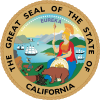
Napa County is a county north of San Pablo Bay in the northern portion of the U.S. state of California. As of the 2010 census, the population was 136,484. The county seat is the City of Napa. Napa County was one of the original counties of California, created in 1850 at the time of statehood. Parts of the county's territory were given to Lake County in 1861.

Sonoma Valley is a valley located in southeastern Sonoma County, California, in the San Francisco Bay Area. Known as the birthplace of the California wine industry, the valley is home to some of the earliest vineyards and wineries in the state, some of which survived the phylloxera epidemic of the 1870s and the impact of prohibition in the early 20th century. Today, the valley's wines are protected by the US Federal Government's Sonoma Valley and Carneros AVAs.
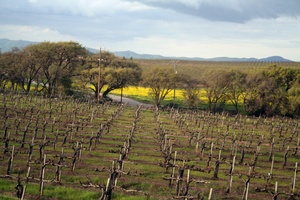
The Livermore Valley AVA is an American Viticultural Area in Alameda County, California, surrounding the city of Livermore in the Tri-Valley region. Both the AVA and the city are named after Robert Livermore, a landowner whose holdings encompassed the valley. The groundwater basin underlying the valley is the Livermore Basin, the largest sub-unit of which is the Mocho Subbasin. The Livermore Basin is one of five aquifers in the San Francisco Bay Area that supply most of the metropolitan Bay Area population. The entire Livermore Basin aquifer faces a concern over elevated total dissolved solids by the year 2020 due to an expanding human population leading to higher rates of return water flows to the aquifer containing certain salts.

The Alexander Valley is a Californian American Viticultural Area (AVA) just north of Healdsburg in Sonoma County. It is home to many wineries and vineyards, as well as the city of Cloverdale. It is the largest and most fully planted wine region in Sonoma. Highway 101 runs through the valley, and the Russian River flows down the valley, surrounded by vineyards on both sides. From the higher elevations of the valley rim, there is a view as far south as Taylor Mountain and Sonoma Mountain. The region was named for Cyrus Alexander, owner of a part of the Rancho Sotoyome Mexican land grant, in 1847. Granted AVA status in 1984, the boundaries of the appellation are defined in the Code of Federal Regulations, Title 27, Section 9.53.
Napa Valley AVA is an American Viticultural Area located in Napa County in California's Wine Country. Napa Valley is considered one of the premier wine regions in the world. Records of commercial wine production in the region date back to the nineteenth century, but premium wine production dates back only to the 1960s.
Knights Valley AVA is an American Viticultural Area (AVA) in Sonoma County, California. One of Sonoma County's original five AVAs, Knights Valley AVA was formally designated an American Viticultural Area on October 21, 1983. Knights Valley AVA includes approximately 37,000 acres (150 km2). Over 30 growers maintain the 2,000 acres (8 km2) planted to wine grape vineyards. The easternmost designated Sonoma County wine region, Knights Valley AVA has the warmest climate in the county. The valley lies between the Alexander Valley AVA and Chalk Hill AVA wine regions to the west and the Mayacamas Mountains to the east. Geographically, the appellation separates the rest of Sonoma County from the Napa Valley AVA.
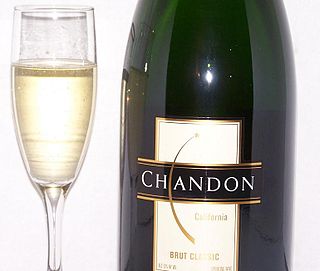
Domaine Chandon is a winery located in Napa Valley in the town of Yountville, California. Established in 1973 by Moët et Chandon, by businessman John Wright and was the first French-owned sparkling wine producer in Napa Valley.

The Suisun Valley AVA is an American Viticultural Area in Solano County, California, located just east of the Napa Valley wine region in the Coast Range. It was established as a wine appellation on 27 December 1982, making it among the first AVAs of California, Napa Valley being the first.

The Mendocino County wine is an appellation that designates wine made from grapes grown mostly in Mendocino County, California. The region is part of the larger North Coast AVA and one of California's largest and most climatically diverse wine growing regions. Mendocino County is one of the northernmost commercial wine grape regions in the state with two distinct climate zones separated by the Mendocino Range. Ten American Viticultural Areas have been designated within Mendocino County. Mendocino is one of the leading wine growing regions for organically produced wine grapes. Nearly 25% of the acreage in Mendocino County is grown organically. In 2004, the residents of the county voted to become the first GMO-free county in the United States in an initiative that was supported by many of the county's largest wineries. The county's widespread focus on organic viticulture has inspired journalists to describe it as "California's organic wine Mecca".
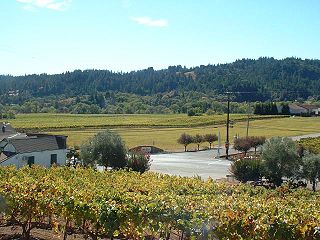
Sonoma County wine is wine made in Sonoma County, California, in the United States.

The Dry Creek Valley AVA is an American Viticultural Area in Sonoma County, California, located northwest of the town of Healdsburg. The valley is formed by Dry Creek, a tributary of the Russian River, and is approximately 16 miles (25.7 km) long and 2 miles (3.2 km) wide. The appellation benefits from the proximity of the Lake Sonoma reservoir for irrigation in this relatively dry area.
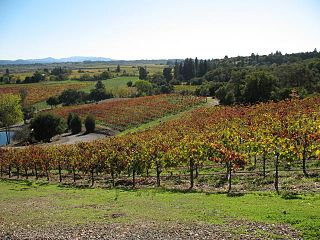
The North Coast AVA is an American Viticultural Area in the state of California that encompasses grape-growing regions in six counties located north of San Francisco: Lake, Marin, Mendocino, Napa, Sonoma, and Solano. This large appellation covers over 3,000,000 acres (12,000 km2) and includes a number of smaller sub-appellations that all share the common ecology trait of weather affected by the cool fog and breezes of the Pacific Ocean.

The Sonoma Valley AVA is an American Viticultural Area in Sonoma County, California, United States which centers on the Sonoma Valley in the southern portion of the county. The appellation is bordered by two mountain ranges: the Mayacamas Mountains to the east and the Sonoma Mountains to the west.
The Mendocino AVA is an American Viticultural Area encompassing Mendocino County, California. Within this larger appellation are several smaller AVAs, and applications are pending with the United States Department of the Treasury Alcohol and Tobacco Tax and Trade Bureau to create new AVAs out of the Sanel and Ukiah valleys along the Russian River. The Mendocino AVA is known for the cultivation of Mediterranean climate grapes including Carignan, Charbono, Grenache, Petite Sirah, Syrah and Zinfandel. The cooler climate in the Anderson Valley is known for its Pinot noir and sparkling wine production. Many wineries in nearby Sonoma and Napa counties purchase Mendocino grapes to blend into wines labeled with other appellations.

The Diamond Mountain District AVA is an American Viticultural Area located in California's Mayacamas Mountains in the northwest portion of the Napa Valley AVA. The appellation sits at a higher elevation than most of Napa Valley's wine region, resulting in less cool fog coming in from San Pablo Bay, and more direct exposure to sunlight. The soil of this AVA is volcanic and very porous which allows it to cool down quickly despite the increased sunlight.

The Spring Mountain District AVA is an American Viticultural Area located in the Napa Valley AVA in California. Spring Mountain District AVA was officially established as an American Viticulture Area in 1993. Encompassed within its bounds are about 8,600 acres (3,480 ha), of which about 1,000 acres (400 ha) are planted to vineyards. Given the small crop yields on hillsides, the region represents less than 2% of Napa Valley wine. Currently the region has just over 30 winegrowers.

California wine is wine made in the U.S. state of California, it supplies a vast majority of the American wine production, along with New Mexico wine these American wine regions are longtime examples of viticulture within New World wine. Almost three quarters the size of France, California accounts for nearly 90 percent of production, the production of wine in California is one third larger than that of Australia. If California were a separate country, it would be the world's fourth largest wine producer.
Napa County wine is wine made in Napa County, California, United States. County names in the United States automatically qualify as legal appellations of origin for wine produced from grapes grown in that county and do not require registration with the United States Department of the Treasury Alcohol and Tobacco Tax and Trade Bureau. The vast majority of Napa County is covered by the boundaries of the world-famous Napa Valley AVA, an American Viticultural Area, and its various sub-appellations. The portion of the county that falls outside of the boundaries of the Napa Valley AVA is northeast of the Chiles Valley AVA, where few grapes are cultivated.

The Calistoga AVA is an American Viticultural Area located in the northern portion of California's Napa Valley AVA. The appellation is distinguished by its volcanic soil, high temperatures up to 100 °F (38 °C) during the day, and cool nights during the growing season due to breezes from the Russian River, causing the highest diurnal temperature variation in the Napa Valley—up to 50 °F (28 °C).


























